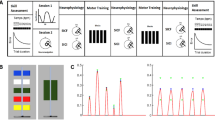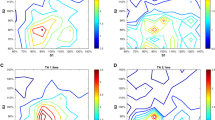Abstract
GABAergic intracortical inhibition (ICI) in human motor cortex (M1) assists fractionated activation of muscles, and it has been suggested that hemispheric differences in ICI may contribute to hand preference. Previous studies of this issue have all been conducted at rest, with conflicting results. Testing during voluntary activation may reveal functionally relevant differences. In normal subjects, we assessed (1) operation of ICI circuits during selective activation of an intrinsic hand muscle at different forces, and (2) whether this differs between right and left hemispheres. Surface EMG was recorded bilaterally from abductor pollicis brevis (APB), first dorsal interosseous (FDI) and abductor digiti minimi (ADM) muscles in eleven right-handed subjects. A circular coil applied paired transcranial magnetic stimulation (TMS) with posteriorly directed current in the brain. Conditioning intensity was 0.8 × active threshold and interstimulus interval was 3 ms. TMS was applied to right or left M1 while subjects were at rest or performing isometric thumb abduction at different forces (0.5, 1, 2, 3, 5 and 10 N) with the contralateral hand. Conditioning TMS was less effective at suppressing the muscle evoked potential in APB during 2–10 N thumb abduction (P < 0.0001) versus rest, but not with lower target forces (0.5, 1 N). Conditioning TMS was less effective for FDI and ADM only during 10 N thumb abduction. We conclude that differential modulation of ICI in M1 during selective muscle activation is a function of target isometric force level. At low forces (<5% MVC), ICI is not modulated for the corticospinal neurons controlling the active or inactive muscles. There is a progressive reduction of ICI effects on corticospinal neurons at higher forces, which is largely restricted to corticospinal neurons controlling the muscle targeted for activation over the range of forces tested (up to ∼25% MVC). The pattern of ICI modulation with selective voluntary muscle contraction was similar in left and right hemispheres during this relatively simple static task. If hemispheric differences in operation of M1 ICI circuits contribute to hand preference, a more challenging finger movement protocol may be needed to demonstrate this asymmetry.




Similar content being viewed by others
References
Awiszus F, Feistner H, Urbach D, Bostock H (1999) Characterisation of paired-pulse transcranial magnetic stimulation conditions yielding intracortical inhibition or I-wave facilitation using a threshold-hunting paradigm. Exp Brain Res 129:317–324
Cantello R, Gianelli M, Bettucci D, Civardi C, De Angelis MS, Mutani R (1991) Parkinson’s disease rigidity: magnetic motor evoked potentials in a small hand muscle. Neurology 41:1449–1456
Cicinelli P, Traversa R, Bassi A, Scivoletto G, Rossini PM (1997) Interhemispheric differences of hand muscle representation in human motor cortex. Muscle Nerve 20:535–542
Cicinelli P, Traversa R, Oliveri M, Palmieri MG, Filippi MM, Pasqualetti P, Rossini PM (2000) Intracortical excitatory and inhibitory phenomena to paired transcranial magnetic stimulation in healthy human subjects: differences between the right and left hemisphere. Neurosci Lett 288:171–174
Civardi C, Cavalli A, Naldi P, Varrasi C, Cantello R (2000) Hemispheric asymmetries of cortico-cortical connections in human hand motor areas. Clin Neurophysiol 111:624–629
Day BL, Dressler D, Maertens de Noordhout A, Marsden CD, Nakashima K, Rothwell JC, Thompson PD (1989) Electric and magnetic stimulation of human motor cortex: surface EMG and single motor unit responses. J Physiol 412:449–473
Di Lazzaro V, Restuccia D, Oliviero A, Profice P, Ferrara L, Insola A, Mazzone P, Tonali P, Rothwell JC (1998) Magnetic transcranial stimulation at intensities below active motor threshold activates intracortical inhibitory circuits. Exp Brain Res 119:265–268
Ditor D, Hicks A (1999) The optimal joint angle for adductor pollicis force production in men and women. Can J Appl Physiol 24:570–580
Fisher RJ, Nakamura Y, Bestmann S, Rothwell JC, Bostock H (2002) Two phases of intracortical inhibition revealed by transcranial magnetic threshold tracking. Exp Brain Res 143:240–248
Geschwind N, Galaburda AM (1985) Cerebral lateralization. Biological mechanisms, associations, and pathology: II. A hypothesis and a program for research. Arch Neurol 42:521–552
Gilbert AN, Wysocki CJ (1992) Hand preference and age in the United States. Neuropsychologia 30:601–608
Hager-Ross C, Schieber MH (2000) Quantifying the independence of human finger movements: comparisons of digits, hands, and movement frequencies. J Neurosci 20:8542–8550
Hammond G (2002) Correlates of human handedness in primary motor cortex: a review and hypothesis. Neurosci Biobehav Rev 26:285–292
Hammond G, Faulkner D, Byrnes M, Mastaglia F, Thickbroom G (2004) Transcranial magnetic stimulation reveals asymmetrical efficacy of intracortical circuits in primary motor cortex. Exp Brain Res 155:19–23
Hanajima R, Ugawa Y, Terao Y, Sakai K, Furubayashi T, Machii K, Kanazawa I (1998) Paired-pulse magnetic stimulation of the human motor cortex: differences among I waves. J Physiol 509:607–618
Hanajima R, Furubayashi T, Iwata NK, Shiio Y, Okabe S, Kanazawa I, Ugawa Y (2003) Further evidence to support different mechanisms underlying intracortical inhibition of the motor cortex. Exp Brain Res 151:427–434
Henkel V, Mergl R, Juckel G, Rujescu D, Mavrogiorgou P, Giegling I, Moller H, Hegerl U (2001) Assessment of handedness using a digitizing tablet: a new method. Neuropsychologia 39:1158–1166
Hess CW, Mills KR, Murray NM (1986) Magnetic stimulation of the human brain: facilitation of motor responses by voluntary contraction of ipsilateral and contralateral muscles with additional observations on an amputee. Neurosci Lett 71:235–240
Ilic TV, Meintzschel F, Cleff U, Ruge D, Kessler KR, Ziemann U (2002) Short-interval paired-pulse inhibition and facilitation of human motor cortex: the dimension of stimulus intensity. J Physiol 545:153–167
Ilic TV, Jung P, Ziemann U (2004) Subtle hemispheric asymmetry of motor cortical inhibitory tone. Clin Neurophysiol 115:330–340
Keel JC, Smith MJ, Wassermann EM (2000) Letter to the editor: a safty screening questionnaire for transcranial magnetic stimulation. Clin Neurophysiol 112:720
Kujirai T, Caramia MD, Rothwell JC, Day BL, Thompson PD, Ferbert A, Wroe S, Asselman P, Marsden CD (1993) Corticocortical inhibition in human motor cortex. J Physiol 471:501–519
Liepert J, Classen J, Cohen LG, Hallett M (1998) Task-dependent changes of intracortical inhibition. Exp Brain Res 118:421–426
Macdonell RA, Shapiro BE, Chiappa KH, Helmers SL, Cros D, Day BJ, Shahani BT (1991) Hemispheric threshold differences for motor evoked potentials produced by magnetic coil stimulation. Neurology 41:1441–1444
Maeda F, Gangitano M, Thall M, Pascual-Leone A (2002) Inter- and intra-individual variability of paired-pulse curves with transcranial magnetic stimulation (TMS). Clin Neurophysiol 113:376–382
Matsumura M, Sawaguchi T, Kubota K (1992) GABAergic inhibition of neuronal activity in the primate motor and premotor cortex during voluntary movement. J Neurophysiol 68:692–702
Nakamura H, Kitagawa H, Kawaguchi Y, Tsuji H (1997) Intracortical facilitation and inhibition after transcranial magnetic stimulation in conscious humans. J Physiol 498(Pt 3):817–823
Oldfield RC (1971) The assessment and analysis of handedness: the Edinburgh inventory. Neuropsychologia 9:97–113
Phillips JG, Gallucci RM, Bradshaw JL (1999) Functional asymmetries in the quality of handwriting movements:a kinematic analysis. Neuropsychology 13:291–297
Reilly KT, Hammond GR (2000) Independence of force production by digits of the human hand. Neurosci Lett 290:53–56
Reynolds C, Ashby P (1999) Inhibition in the human motor cortex is reduced just before a voluntary contraction. Neurology 53:730–735
Ridding MC, Rothwell JC (1999) Afferent input and cortical organisation: a study with magnetic stimulation. Exp Brain Res 126:536–544
Ridding MC, Sheean G, Rothwell JC, Inzelberg R, Kujirai T (1995a) Changes in the balance between motor cortical excitation and inhibition in focal, task specific dystonia. J Neurol Neurosurg Psychiatry 59:493–498
Ridding MC, Taylor JL, Rothwell JC (1995b) The effect of voluntary contraction on cortico-cortical inhibition in human motor cortex. J Physiol 487:541–548
Roshan L, Paradiso GO, Chen R (2003) Two phases of short-interval intracortical inhibition. Exp Brain Res 151:330–337
Rosler KM, Petrow E, Mathis J, Aranyi Z, Hess CW, Magistris MR (2002) Effect of discharge desynchronization on the size of motor evoked potentials:an analysis. Clin Neurophysiol 113:1680–1687
Rossini P, Barker A, Berardelli A, Caramia M, Caruso G, Cracco R, Dimitrijevic M, Hallett M, Katayama Y, Lucking C, Maertens de Noordhout A, Marsden C, Murray N, Rothwell J (1994) Non-invasive electrical and magnetic stimulation of the brain, spinal cord and roots: basic principles and procedures for routine clinical application. Report of an IFCN committee. Electroencephalogr Clin Neurophysiol 91:79–92
Semmler JG, Nordstrom MA (1998) Hemispheric differences in motor cortex excitability during a simple index finger abduction task in humans. J Neurophysiol 79:1246–1254
Stinear CM, Byblow WD (2003) Role of intracortical inhibition in selective hand muscle activation. J Neurophysiol 89:2014–2020
Tiffin J (1987) Purdue Pegboard. MacMillan/McGraw-Hill, Park Ridge, Ill, USA
Tokimura H, Ridding MC, Tokimura Y, Amassian VE, Rothwell JC (1996) Short latency facilitation between pairs of threshold magnetic stimuli applied to human motor cortex. EEG Clin Neurophysiol 101:263–272
Triggs WJ, Calvanio R, Macdonell RA, Cros D, Chiappa KH (1994) Physiological motor asymmetry in human handedness: evidence from transcranial magnetic stimulation. Brain Res 636:270–276
Triggs WJ, Subramanium B, Rossi F (1999) Hand preference and transcranial magnetic stimulation asymmetry of cortical motor representation. Brain Res 835:324–329
Werhahn KJ, Kunesch E, Noachtar S, Benecke R, Classen J (1999) Differential effects on motorcortical inhibition induced by blockade of GABA uptake in humans. J Physiol 517(Pt 2):591–597
Ziemann U, Hallett M (2001) Hemispheric asymmetry of ipsilateral motor cortex activation during unimanual motor tasks:further evidence for motor dominance. Clin Neurophysiol 112:107–113
Ziemann U, Lonnecker S, Steinhoff BJ, Paulus W (1996a) Effects of antiepileptic drugs on motor cortex excitability in humans: a transcranial magnetic stimulation study. Ann Neurol 40:367–378
Ziemann U, Lonnecker S, Steinhoff BJ, Paulus W (1996b) The effect of lorazepam on the motor cortical excitability in man. Exp Brain Res 109:127–135
Ziemann U, Chen R, Cohen LG, Hallett M (1998a) Dextromethorphan decreases the excitability of the human motor cortex. Neurology 51:1320–1324
Ziemann U, Tergau F, Wischer S, Hildebrandt J, Paulus W (1998b) Demonstration of facilitatory I wave interaction in the human motor cortex by paired transcranial magnetic stimulation. Electroencephalogr Clin Neurophysiol 109:321–330
Zoghi M, Pearce SL, Nordstrom MA (2003) Differential modulation of intracortical inhibition in human motor cortex during selective activation of an intrinsic hand muscle. J Physiol 550:933–946
Acknowledgments
The work described herein forms part of the PhD studies of M. Zoghi, who was supported by a scholarship from The University of Adelaide. This project was funded by a grant (157975) from the NHMRC of Australia.
Author information
Authors and Affiliations
Corresponding author
Rights and permissions
About this article
Cite this article
Zoghi, M., Nordstrom, M.A. Progressive suppression of intracortical inhibition during graded isometric contraction of a hand muscle is not influenced by hand preference. Exp Brain Res 177, 266–274 (2007). https://doi.org/10.1007/s00221-006-0669-2
Received:
Accepted:
Published:
Issue Date:
DOI: https://doi.org/10.1007/s00221-006-0669-2




